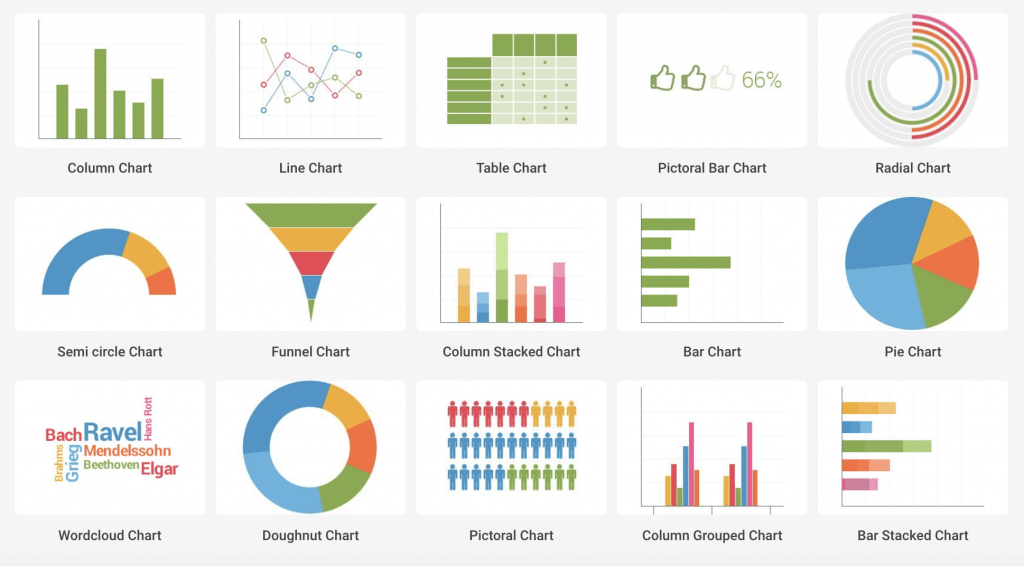14.05.2024 by Infogram
Data journalism is no longer a niche field. Today’s reporters need to be storytellers who can not only craft compelling narratives but also use the power of data to address complex issues. But what does it take to thrive in this dynamic field? In this article, we’re going to explore must-have data journalism skills, best practices, and the perfect data visualization tool that can help you elevate your data-driven storytelling.

Data journalist’s arsenal: Key data journalism skills
Data journalists are known for their ability to turn complex data sets into clear, compelling narratives that inform the public and hold powerful institutions accountable. While success in this field requires a diverse skill set, let’s delve into the five core data journalism skills:
1. Data wrangling: Organizing the chaos
Before there’s a story, there’s data – lots of it. While data wrangling appears as a mundane task of cleaning and organizing messy data sets, for data journalists, it’s the crucial first step that unlocks the power of data to tell impactful stories.
Data wrangling involves cleaning, organizing, and manipulating raw data sets to prepare them for analysis. Think of it as transforming messy information into a usable format. Real-world data often comes riddled with inconsistencies, missing values, and formatting errors. Data wrangling allows you to identify and address these issues, ensuring the accuracy and reliability of your analysis. You’ll be adept at using spreadsheet software and potentially some coding to automate repetitive tasks. Data wrangling may not be glamorous, but it’s the foundation for any successful data journalism project.
2. Data analysis: Discovering the story within
Once your data is wrangled, you need to analyze it. Data itself doesn’t speak. Data analysis allows data journalists to interpret the numbers, translate them into understandable terms, and extract the stories waiting to be told.
Analysis of data can also involve statistical calculations and interpretation. Knowing how to calculate basic statistical measures like mean, median, and standard deviation allows you to summarize your data effectively. But data analysis goes beyond just crunching numbers. You need to ask the right questions, formulate a hypothesis – a tentative explanation you aim to prove or disprove using the data – and choose the appropriate statistical techniques to extract meaningful information from the data. Don’t just analyze data blindly; let your curiosity guide you to discover the hidden stories within the numbers.
3. Storytelling: Creating captivating narratives
While data is the backbone of data journalism, the true power of data journalism lies in its ability to connect with people on a human level. This is where the skill of effective storytelling comes in, transforming dry numbers into compelling narratives that resonate with audiences.
As a data journalist, you need to be able to take the insights from your analysis and weave them into a captivating story. Don’t just present facts and figures; use data to illustrate human stories, paint vivid pictures, and evoke emotions in your readers. Think impactful headlines, clear and concise language, and a narrative arc that keeps the audience engaged. Data visualization plays a crucial role here, but it’s your storytelling skills that breathes life into the analysis and makes it truly impactful. Ultimately, storytelling allows you to connect with readers on an emotional level.
Learn more about creating an effective data story in this blog article: Data storytelling: Ingredients to an effective data story.
4. Critical thinking: An eye for truth
Data journalism thrives on the power of information, but not all information is created equal. A critical eye is essential. You need to question the data’s source, identify potential biases, and avoid jumping to conclusions. Look for the deeper meaning and context within the numbers.
Data can be manipulated, so it’s crucial to understand how it was collected and by whom. Are there any inherent biases in the data set? What historical trends does the data compare to? Consider the limitations of the data and acknowledge them in your reporting. Don’t be afraid to challenge assumptions and dig deeper to uncover the full story. Critical thinking ensures your data journalism is honest, accurate, and avoids misleading the public.
5. Data visualization: Making the complex clear
Numbers can be an intimidating language for many readers. Data visualization acts as a translator, converting complex data sets into charts, graphs, and maps that are easier to grasp. Ultimately, data visualizations are the bridge between complex data and clear understanding.
It’s important for data journalists to use effective data visualization tools to create charts, graphs, and maps that inform and engage readers.
Also, learning to understand which chart type best represents your data is key. For example, a pie chart is great for showcasing proportions, while a bar chart is for displaying comparisons, and a scatter plot will effectively show relationships. Ultimately, each chart serves a specific purpose.

However, data visualization goes beyond just choosing the right chart. Aesthetics matter – so make sure to use color palettes, fonts, and layouts that are clear, professional, and complement your story’s tone. Consider incorporating interactive elements to allow your audience to explore the data themselves and personalize their experience. Effective data visualization transforms dry numbers into engaging visuals that illuminate the story you’re trying to tell.
Best practices: The guide to data storytelling for data journalists
As you develop your data journalism skill set, keep in mind the best practices to elevate your data journalism game:
Ask the right questions: Before diving into data, define your story’s goal and what questions the data can answer. What are you trying to uncover? What impact do you want to make?
Prioritize accuracy: Ensure your data is accurate and consistent before analysis. Take the time to clean and organize your data sets to avoid misleading conclusions.
Visualize effectively: Choose charts that best represent your data and avoid overloading your audience with information. Sometimes a simple bar chart is more impactful than a complex infographic.
Context is king: Always provide context to your data – what does it mean, and why is it important? Explain the historical trends, compare it to relevant benchmarks, and highlight any outliers.
Be transparent: Explain your methodology and acknowledge limitations of the data. Let your readers understand the process behind your analysis and be upfront about any potential biases or limitations in the data set itself.

Infogram: A key tool for any data journalist
There’s a wide range of data journalism tools available, each with its strengths. However, when it comes to visualizing data, Infogram stands out with its focus on creating easy-to-understand and interactive visualizations, perfect for storytelling with data. Let’s take a closer look at Infogram and what it offers to data journalists:
Effortless data viz creation with AI: Infogram prioritizes user experience with a drag-and-drop interface. This empowers data journalists, regardless of technical expertise, to create impactful data visualizations. Plus, Infogram takes this a step further by incorporating an AI-powered infographic and chart generator that lets you create impactful charts and infographics in seconds! By simply feeding your data into the platform, Infogram’s AI places your data neatly into the chosen chart or infographic. This AI-powered feature streamlines the design process, allowing data journalists to focus on refining the data story and message.
Pre-built efficiency and AI text-editing tool: Infogram has a library of pre-designed templates. These templates cater to a wide range of data types, including everything from bar charts to complex geographical visualizations. This eliminates the need to start from scratch, saving you valuable time. However, Infogram doesn’t stop there. Its AI text-editing feature helps ensure your message resonates. The AI can summarize lengthy text, ensuring key points are clear, or expand underdeveloped sections for impactful storytelling.
Interactive storytelling: Infogram transforms static charts, offering a suite of interactive elements that elevate audience engagement. Data journalists can leverage annotations, tooltips, and even allow viewers to filter and explore data on their own. This empowers audiences to delve deeper into the information, fostering a richer understanding of the data story. Ultimately, Infogram empowers data journalists to present information not just as results, but as an interactive experience.
Streamlined collaboration: Recognizing the collaborative nature of data journalism, Infogram facilitates teamwork through real-time, multi-user editing. This enables data journalists to seamlessly collaborate with editors, designers, and fellow data journalists. Also, Infogram streamlines the revision process, fostering a collaborative environment where data stories can be refined and perfected before publication.
The future is data-driven
Data journalism is a powerful and growing field that leverages data to uncover hidden trends and expose injustices. Data journalism empowers citizens to make informed decisions and fosters a more transparent society. And by developing your data journalism skills, embracing best practices, and leveraging tools like Infogram, you can become a data journalist who informs, enlightens, and sparks action with the power of data. Try Infogram today!
Get data visualization tips every week:
New features, special offers, and exciting news about the world of data visualization.